While Americans stayed “home together” in 2020, depleting flour reserves in pursuit of the perfect sourdough starter, another commodity sold out and skyrocketed to record sales. Guns.
Americans bought an estimated 22.8 million of them in 2020—the highest number in U.S. history. In 2021, just under 20 million guns were sold, making it the second highest year of purchases. Forty percent of those purchases went to first-time gun buyers, according to the National Shooting Sports Foundation. NORC at the University of Chicago estimates that one in five American households bought a gun between March 2020 and March 2022.
At the same time, guns have broken other recent records, becoming the leading cause of death among children and teenagers. There were more deadly school shootings in the 2020-2021 school year than any other year on record. And researchers report that the number of teens who carry handguns has grown by 41% in the last two decades.
Experts disagree about what accounts for the rise in gun purchases, first-time ownership, and youth gun-carrying. But as death rates increase in tandem with sales figures, some turn to the gun industry itself for answers and accountability. And some, like California governor Gavin Newsom—who signed an emergency order in June banning the marketing of guns to minors—are examining the role that marketing plays in this twin surge.
The 2005 Protection of Lawful Commerce in Arms Act protects gunmakers from responsibility for crimes committed with their weapons. But the law is murky in one respect—marketing. In February, the families of nine of the Sandy Hook shooting victims won a landmark $73 million dollar settlement against Remington Arms for its marketing of the AR-15 to young men. The Uvalde families are mounting a similar lawsuit against Daniel Defense.
This isn’t the first time that Remington’s marketing to youth has come under legal scrutiny—it’s just the first time they were held liable. In 1991, a Texas woman filed a lawsuit arguing that a 16-page advertising supplement in Boys’ Life magazine, sponsored by Remington and others, led her 12-year-old son and his friends to experiment with a gun, resulting in the boy’s death. The court eventually found that the fatality was not a “reasonably foreseeable consequence” of Remington’s advertising.
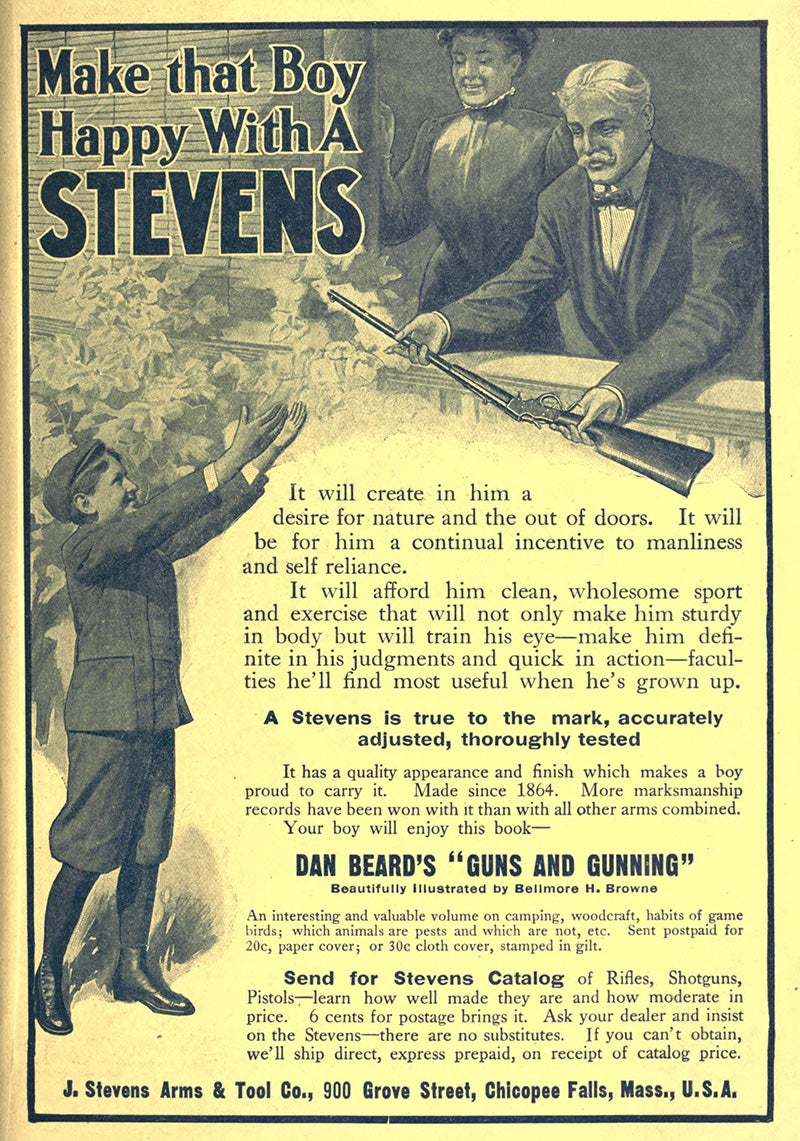
Courts have historically erred on the side of preserving a gunmaker’s right to market to children, write lawyers Anne G. Kimball and Sarah L. Olson, holding that “the unfortunate fact that firearms can be misused, either criminally or carelessly, to cause injury cannot form the basis for liability…because that fact is common knowledge.” In other words, courts have long held that marketing guns to children is protected speech under the First Amendment because it’s assumed that kids already know guns are deadly.
The 2022 Remington settlement changed that. The Sandy Hook families prevailed on the argument that Remington marketed their weapons to teenage boys by glorifying militaristic killing and death. Concerns over this very gun glorification prompted Newsom to make his announcement about California’s gun marketing ban. He released a video; in it Newsom stands in front of two cartoon skull and crossbones with pacifiers in their mouths—ad graphics for the JR-15, an assault-style rifle for children released by WEE1 Tactical earlier this year. Its marketing copy speaks directly to kids; the mini assault rifle “looks, feels, and operates just like Mom and Dad’s gun.”
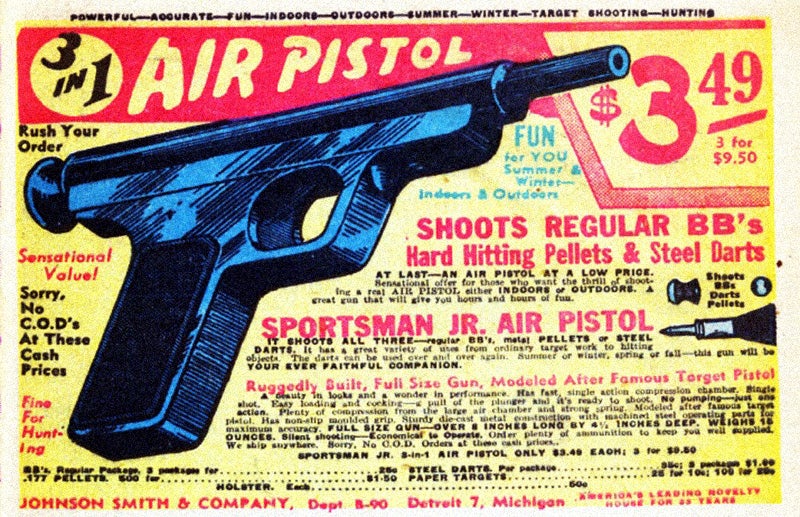
The Remington settlement and Newsom’s description of an assault rifle for kids as “vile” represent a significant change in the conversation around gun violence and children—and what marketing has to do with it. Throughout much of the 20th century, shooting was marketed — and, in many cases, perceived by the public—as a “wholesome, clean sport that everyone in the family could enjoy” writes Jay Mechling in “Boy Scouts, the National Rifle Association, and the Domestication of Rifle Shooting.” This was due, in no small part, to aggressive marketing campaigns targeting millions of boys and a partnership between the National Rifle Association (NRA) and The Boy Scouts of America (BSA).
While rural boys learned to shoot rifles in the 18th and 19th centuries as part of farm and frontier life, gunmakers drastically expanded production during and after the Civil War, and found that post-war rural and hunting demands couldn’t keep up with supply. The early 20th century saw a concerted effort on the part of the gun industry to nurture a desire for guns in urban and suburban youth. This market didn’t need guns, but gun manufacturers with eyes on their bottom line believed that boys should be taught to want them. At the same time, there was a sense of national “panic,” writes Mechling, over American manhood. He describes the years following the Civil War as “decades marked by economic uncertainty, increased immigration, urbanization, and social Darwinian worries that modern society was feminizing American men.”
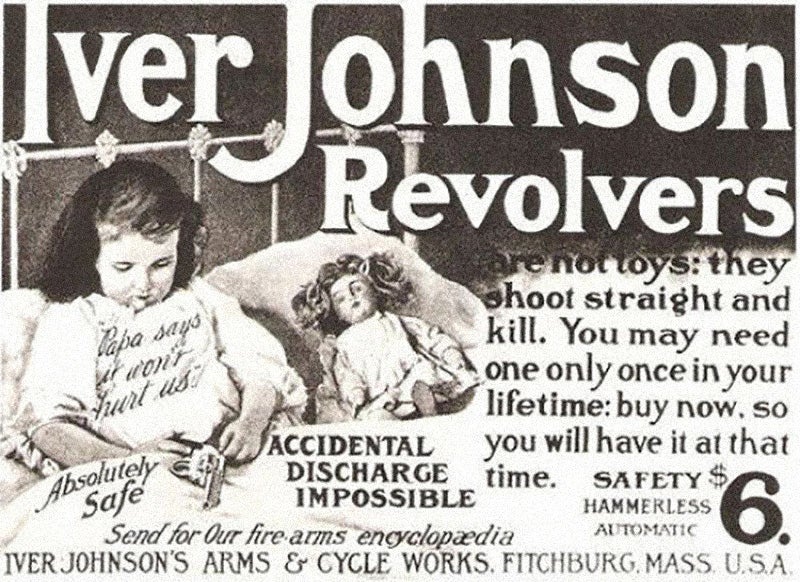
The NRA responded to national concerns over the waning of “masculine virtue” by founding its youth programs in 1903, aimed at urban and suburban boys. Soon thereafter, in 1910, the BSA was founded “for the boys who’d paid the price of urban civilization and who were far removed from the wilderness experience that fostered manly virtues like self-reliance and physical fitness,” Mechling continues. The BSA actively distanced itself from being perceived as a paramilitary organization, instead “linking rifle marksmanship to responsible democratic citizenship and to masculine virtues of self-control.” Boys were taught to see guns, not as weapons of war and killing, but as symbols of American patriotism and peacekeeping. (In line with this vision of guns as keepers of the peace—the Colt revolver was known as the “Peacemaker.” “The good people of this world are very far from being satisfied with each other,” Samuel Colt once wrote, “my arms are the best peacemakers.”)
Gunmakers, too, promoted guns as tools for a boy’s character development—not killing. In The Gunning of America, historian Pamela Haag details how The Winchester Repeating Arms Company developed a “boy plan” in 1918, to invite 3,363,537 boys into their Junior Rifle Corps through direct-mail campaigns. Ad slogans decreed that every “real boy” wanted a Winchester rifle to cultivate “sturdy manliness.” When parents resisted—dealers often complained that Mom and Dad weren’t eager customers—“Winchester urged retailers to appeal to the source, not to the parents, and tell their ‘boy customers’ about their rifles,” Haag details. Marketing for the Daisy Air Rifle similarly directly addressed their target consumers: “Tell Dad that you want a Daisy…that you want as much good, clean, fun, and as much chance to be a man, as he had.” Daisy promised children their product “makes you ready for the big gun—the kind Dad uses now.”
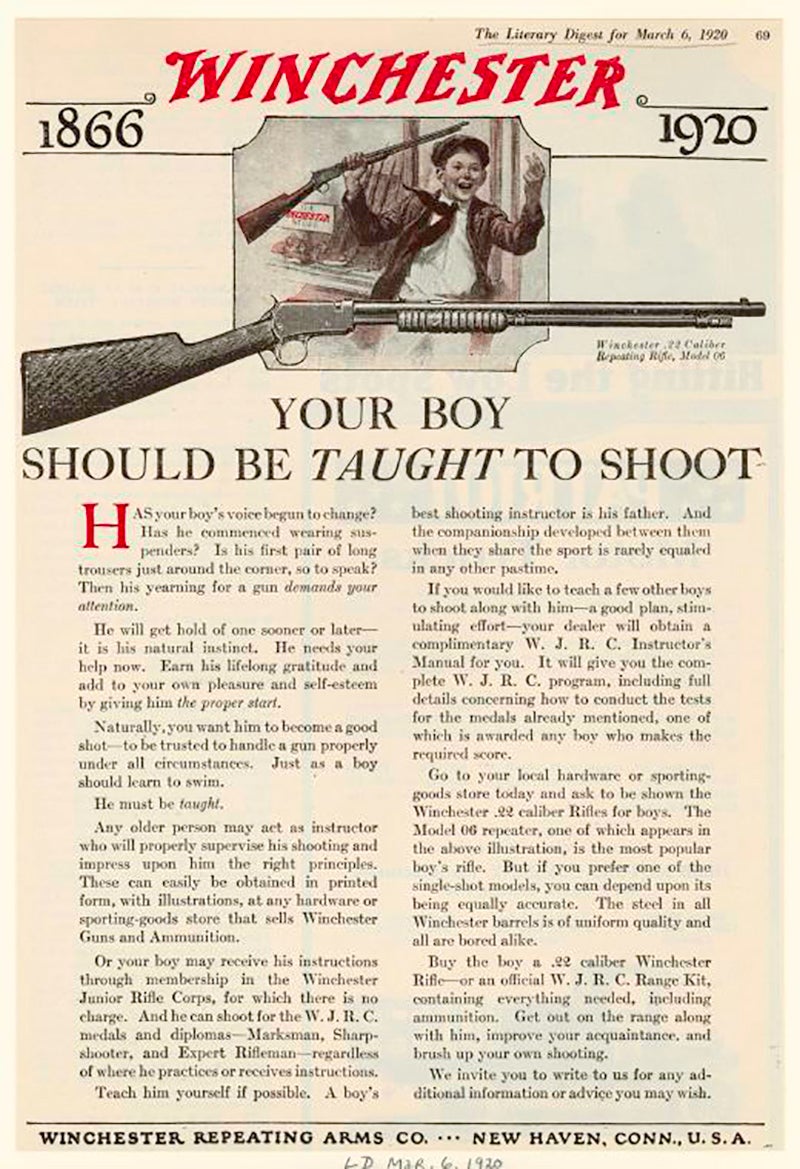
To win over parents, Winchester published headlines proclaiming, “Your boy should be taught to shoot.” Such ads reinforced shooting as a natural part of a child’s development into manhood, with copy that read, “Has your boy’s voice begun to change? … Then, his yearning for a gun demands your attention…earn his lifelong gratitude and add to your own pleasure and self-esteem by giving him the proper start. Naturally, you want him to become a good shot…just as a boy should learn to swim.”
In this way, Winchester, Daisy, and the BSA were in lockstep around positioning the gun as a “wholesome” part of outdoor fun. In 1916, Remington released its own children’s book with the same approach: How a Boy Made the First Remington. In an eerie foreshadow of the Remington lawsuit over the romanticization of guns to teenage boys, The National Hardware Bulletin wrote that the book “deals with firearms in a way that is actually tingling with romance.”
This romantic emphasis on guns as a building block to American manhood continued into the 1940s. But while organizations like the BSA worked to separate youth shooting from images of war, the beginnings of the Cold War era saw a resurgence in national anxiety about the feminization of American men and boys. “The rhetoric of the Cold War was filled with talk about strength and weakness,” writes Mechling, “about ‘hard’ and ‘soft’ bodies, about ‘hard’ and ‘soft’ stances toward Communism, and about aggressiveness and passivity. A strong America required strong male bodies that embodied (literally and metaphorically) American national identity.”
Parents who once had to be convinced to buy their boys a gun now “gladly bought toy guns and plastic armies,” Mechling says. Television stations played Western and World War II films, dime store novels about gunslingers and war heroes abounded, and, in turn, boys brought these stories into their play. Toy guns were fixtures of “playing soldier” or “cowboys and Indians.” The BSA may have tried to distance guns from war and killing, but for middle-class boys of the time, masculinity was entwined with the war and death scenes they saw on the news, in movies, and in popular books—often sponsored by Winchester and Remington. Gun marketers more overtly linked patriotism and death than they had in years before, all in the name of peacekeeping. A 1950s Remington comic book features teenagers holding rifles. “Remington rifles helped blaze the trail to America’s glory,” its text reads. But it was the beginning of the end of the gun’s largely unblemished reputation as a “wholesome” emblem of American values.
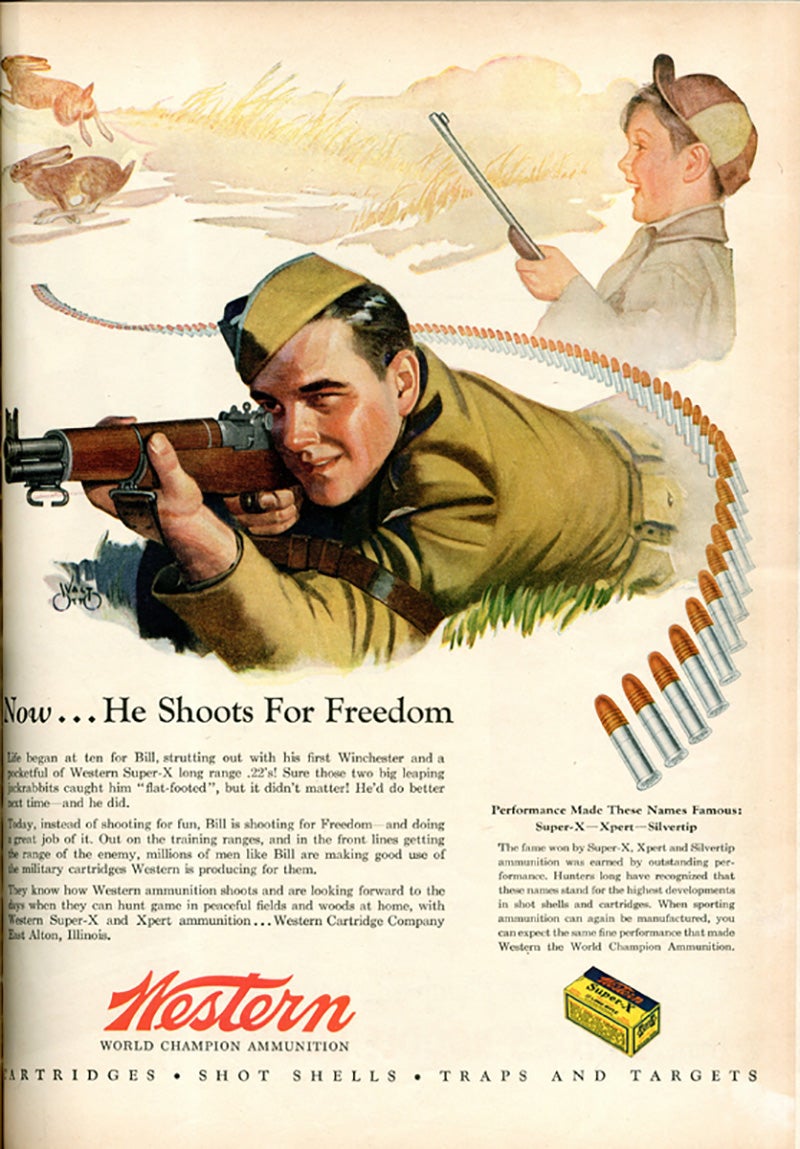
According to Mechling, the 1950s were “the golden age of sport hunting for the middle class.” This was in in contrast to the stark shift that took place in the following two decades, as gun violence rose and the antiwar movement took shape. Toy guns and war toys became increasingly controversial. The BSA began distancing its youth shooting programs from the NRA and focused its messaging around wildlife conservation and safety. Accordingly, gunmakers scaled back their ads targeting youth, while adapting their adult ads to focus on animals, not people, as targets. “Winchester’s New Model 770 is designed to make coyote, cougar, caribou and the competition bite the dust,” reads one 1970 magazine ad, depicting a lone gun against a brown leather background. Contrast this with a 1944 Winchester ad featuring a soldier aiming a rifle at the “enemy” with the headline: “Now…He Shoots For Freedom.”
At the end of the 1970s, gun ownership started to steadily decline, continuing downward for over three decades. After that, what Mechling calls a “remasculization” of American culture took hold in response to “the Vietnam syndrome,” and the perceived accompanying emasculation of the nation. Gun marketing boomed once again and, with it, a new kind of war toy “that represented males as machines,” as Wendy Varney details in “Of Men and Machines: Images of Masculinity in Boys’ Toys.” The 1980s and ‘90s saw a surge of technology-based toys like Men of Steel, Beast Machines, and Transformers that were half man, half weapon, linking masculinity to being machine-like.
Still, gunmakers grappled with plummeting profits and an aging market. They responded by grooming younger customers. In 1996, the NRA’s then-president Marion Hammer declared the organization in “an old-fashioned wrestling match for the hearts and minds of our children… we’d better engage our adversaries with no holds barred.” In 2002, the NRA invested $100 million “in a campaign to bring together children and guns,” writes Garen J. Wintemute. This campaign to “recruit a new generation of young shooters,” Mechling further explains, included “publishing a magazine, Junior Shooters, giving firearms and ammunition to youth groups; sponsoring shooting competitions; and marketing rifles specifically designed and advertised to appeal to young shooters.”
Twenty years on, some may look at the historic gun sales of 2020 and 2021 and call these efforts successful. Others want to leave the era of marketing guns to kids to history. Gun manufacturers and advocates decidedly do not. They invoke First Amendment rights and brand recent marketing bans as as “an attempt to wipe out the next generation of hunters and shooters,” according to California Rifle & Pistol Association President and General Counsel, Chuck Michel.
The next frontier for gunmakers to sponsor “kidfluencers” as a way to skirt rules prohibiting firearm sales on social media. A century ago, Winchester slogans declared that “every real boy” wants a gun. Today’s advertisers don’t need those slogans, since real boys sell that message themselves.
Support JSTOR Daily! Join our new membership program on Patreon today.




